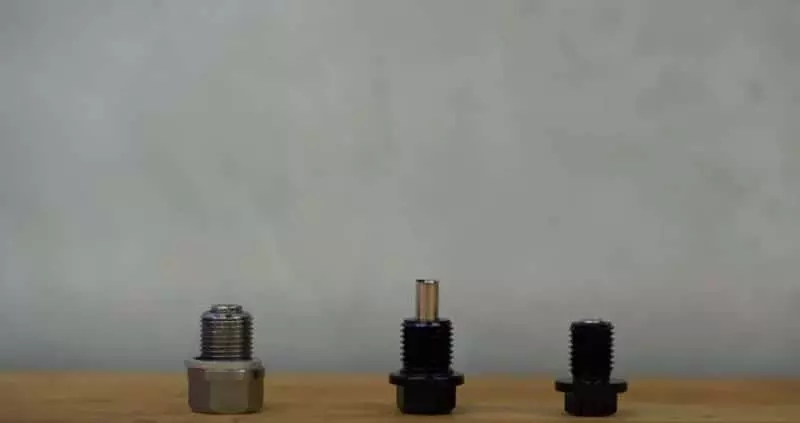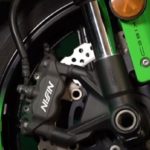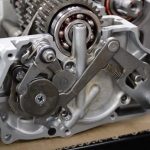If you care about your motorcycle, you probably want to do everything you can to keep your engine healthy. In which case, you might be considering installing a magnetic drain plug to help your oil stay clean. But are magnetic drain plugs effective? Or is there a better option, and if they work, why don’t all motorcycles have them?
The idea is that the magnetic drain plug sits at the bottom of the engine, and as oil swirls past it, the magnet will attract and trap any ferromagnetic metals present in the oil. So, anything that will give your engine a longer life as smart as this device is worth every cent you spend on it.
That means the magnet will attract steel alloys like those used in your bearings in your crankshaft, but it won’t affect the aluminum used in stuff like your piston and your clutch basket.

Do Magnetic Drain Plugs Work On Motorcycles?
Using one in your engine will have a slimy fuzz of material on it when you pull it out at your next oil change.
The crud collects normal wear particles shed off stuff like your primary gear, transmission gears, and piston rings. The real question is whether getting this gunk out of your oil even matters and if you need a magnet to do it.
Well, the manufacturers don’t seem to think so, or else they would install magnetic drain plugs in their bikes at the factory, and the vast majority don’t.
Now, bikes with drive shafts often have a magnetic drain plug for the final gear case, but that’s because there isn’t a filter to keep the gear oil clean.
On the other hand, your engine does have a filter, and it happens to be very efficient at removing harmful particulates from the lube. Now your average oil filter is going to remove anything larger than 35 microns a micron is one-millionth of a meter, so 35 microns is pretty damn small.

For reference, human hair is about 50 microns, a speck of pollen dust is about 30 microns, and a tiny little red blood cell that’s only eight microns. And you know how magnets only work on ferromagnetic metals like iron, cobalt, and nickel?
Well, filters don’t discriminate, so whether it is steel aluminum bits of gasket carbon from combustion or shrapnel from your clutch plates, if it’s larger than 35 microns, the filter is going to grab it.
But what about the particles that are smaller than 35 microns? That’s where the proponents of magnetic drain plugs get really excited because the magnet is going to grab ferrous fragments out of the oil regardless of how small they are.
And as it turns out, it’s the really tiny stuff like the 1 to 10-micron particles that are the most damaging because they’re small enough to fit into the clearance between parts like your piston rings and your cylinder walls.
Plus, steel is one of the hardest materials slothed off inside your motor, so it’s potentially the most damaging. And if you can remove it by simply putting a magnet in your sump, then why wouldn’t you?
When it comes down to it, magnetic drain plugs are just an added layer of protection for your engine and, based on the sludge that I’ve wiped off magnets, and seem pretty effective.
Now apparently, manufacturers don’t deem them necessary for long-term engine reliability, but you might feel otherwise as an owner. Plus, magnetic drain plugs are affordable; they’re easy to install, and some of them even come pre-drilled for safety wire which is great if you’re headed to the track.
However, there are some things to look out for, even on something as straightforward as a drain plug. Many of them are made out of aluminum which is nice because it’s lightweight, and you can often get them in all sorts of cool anodized colors.
But aluminum is not magnetic, so that means the magnet has to be glued to the plug, and on cheaper parts, it’s not always glued particularly well.
That means the magnet could conceivably come off and stick; who knows where inside your engine. Another thing I’ve seen is aluminum drain plugs improperly labeled as having been machined from billet, which is strong and durable.
When in fact, the part is machined from casting, which will be inherently brittle. The result is snatched drain plugs well before you’ve reached the recommended torque.
A free-floating magnet and a sheared-off drain plug are both really crappy scenarios, especially when you thought you’re going to be doing something quick and helpful for your engine.
But you can avoid it by not buying cheapo no-name crap off of amazon. You should stick with a reputable brand, or you can just buy a steel drain plug that is going to be strong and inherently magnetic.
And of course, don’t forget to compare the thread pitch of your original drain plug to your new drain plug to make sure they match.
I know 12 millimeters by 1.5 and 12 by 1.25 seem awfully close, but I promise you they are not the same. Also, don’t worry if your new drain plug is a little longer than the old one, and no parts are spinning anywhere near the bottom of the sump.
The last knit I’ll pick about magnetic drain plugs is that they’re not in a great position to do their job well. they’re down there in the engine sump where the oil just sort of sloshes around. So to really be effective, the magnet needs to be in the oil flow, which is why I run a magnet on my oil filter.
Donut magnets from motion pro sit right on the oil filter, so they’re exposed to all of the engine oil, and they get the opportunity to snatch every errant particle. These guys work on spin-on filters as well as cartridge filters, and they’re more effective than magnetic drain plugs. But hey, if you’re serious about protecting your engine, just run both.
Popular Posts
- 4 Things To Wear To Stay Warm On Your Motorcycle In Winter
 Most of us here ride to work every day all year round, and we have lots of personal experience when it comes to taming the elements.
Most of us here ride to work every day all year round, and we have lots of personal experience when it comes to taming the elements. - How To Clean Your Motorcycle In 5 Easy Steps
 We all love a clean and shiny motorcycle but knowing which cleaning products to buy can sometimes be a little daunting, and so too can be the method to clean your motorcycle.
We all love a clean and shiny motorcycle but knowing which cleaning products to buy can sometimes be a little daunting, and so too can be the method to clean your motorcycle. - How Does A Manual Transmission Work On A Motorcycle
 For most people, their motorcycle transmission is one of the most mysterious parts of their bike. How does it work, and why do we shift down into first, but then
For most people, their motorcycle transmission is one of the most mysterious parts of their bike. How does it work, and why do we shift down into first, but then
Table Of Content


